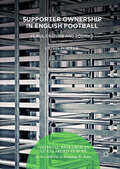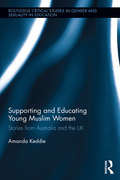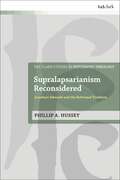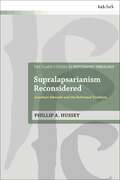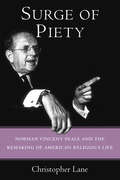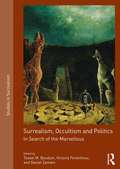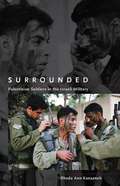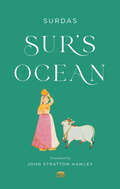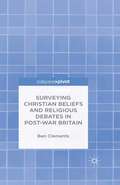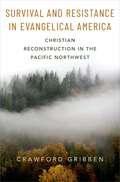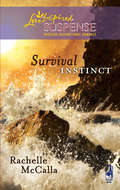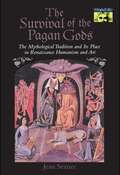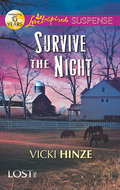- Table View
- List View
Superstition: Belief in the Age of Science
by Robert L. ParkFrom uttering a prayer before boarding a plane, to exploring past lives through hypnosis, has superstition become pervasive in contemporary culture? Robert Park, the best-selling author of Voodoo Science, argues that it has. In Superstition, Park asks why people persist in superstitious convictions long after science has shown them to be ill-founded. He takes on supernatural beliefs from religion and the afterlife to New Age spiritualism and faith-based medical claims. He examines recent controversies and concludes that science is the only way we have of understanding the world. Park sides with the forces of reason in a world of continuing and, he fears, increasing superstition. Chapter by chapter, he explains how people too easily mistake pseudoscience for science. He discusses parapsychology, homeopathy, and acupuncture; he questions the existence of souls, the foundations of intelligent design, and the power of prayer; he asks for evidence of reincarnation and astral projections; and he challenges the idea of heaven. Throughout, he demonstrates how people's blind faith, and their confidence in suspect phenomena and remedies, are manipulated for political ends. Park shows that science prevails when people stop fooling themselves. Compelling and precise, Superstition takes no hostages in its quest to provoke. In shedding light on some very sensitive--and Park would say scientifically dubious--issues, the book is sure to spark discussion and controversy.
Supporter Ownership in English Football: Class, Culture and Politics (Football Research in an Enlarged Europe)
by Chris PorterThis book presents a fresh perspective on football fandom in England, going beyond existing debates surrounding the structural transformations English football has seen in recent decades, to consider the contested cultural ground upon which football fandom exists. Supporter Ownership in English Football connects cultural conflict experienced across society associated with negotiating structural changes such as globalisation, commodification and social exclusion, with supporter ownership in football – which is in itself an expression and reflection of broader social and political shifts in class-consciousness. Discourses of identity, authenticity, loyalty, ownership and above all, the possibilities and limitations for ordinary people to influence change, play a decisive role in how fans come to decide whether they could, or should, have a meaningful say in the future of their club and the game itself. While celebrating the achievements, progress and potential of the supporter ownership movement, the book is also careful to take account of the various setbacks, contradictions and limiting tendencies that continue to shape its developmental trajectory.Porter’s relation of football supporter ownership to the political and social class dynamics of contemporary society will be of interest to scholars of sport studies, sociology, cultural studies and politics, and those interested in social movements, consumerism, identity, authenticity and community.
Supporting and Educating Young Muslim Women: Stories from Australia and the UK (Routledge Critical Studies in Gender and Sexuality in Education)
by Amanda KeddieThis book draws on the stories of female educators and young Muslim women to explore issues of identity, justice and education. Situated against a backdrop of unprecedented Islamophobia and new articulations of ‘White-lash’, this book draws on case study research conducted over a ten-year period and provides insight into the diverse worlds of young Muslim women from education and community contexts in Australia and England. Keddie discusses the ways in which these young women find spaces of agency and empowerment within these contexts and how their passionate and committed educators support them in this endeavour. Useful for researchers and educators who are concerned about Islamophobia and its devastating impacts on Muslim women and girls, this book positions responsibility for changing the oppressions of Islamophobia and gendered Islamophobia with all of us. Such change begins with education. The stories in this book hope to contribute to the change process.
Supporting and Educating Young Muslim Women: Stories from Australia and the UK (Routledge Critical Studies in Gender and Sexuality in Education)
by Amanda KeddieThis book draws on the stories of female educators and young Muslim women to explore issues of identity, justice and education. Situated against a backdrop of unprecedented Islamophobia and new articulations of ‘White-lash’, this book draws on case study research conducted over a ten-year period and provides insight into the diverse worlds of young Muslim women from education and community contexts in Australia and England. Keddie discusses the ways in which these young women find spaces of agency and empowerment within these contexts and how their passionate and committed educators support them in this endeavour. Useful for researchers and educators who are concerned about Islamophobia and its devastating impacts on Muslim women and girls, this book positions responsibility for changing the oppressions of Islamophobia and gendered Islamophobia with all of us. Such change begins with education. The stories in this book hope to contribute to the change process.
Supporting Modern Teaching in Islamic Schools: Pedagogical Best Practice for Teachers
by Ismail Hussein AmzatSupporting Modern Teaching in Islamic Schools: Pedagogical Best Practice for Teachers advocates the revamp of the madrasah system and a review of the Islamic curriculum across Muslim countries and emphasises training needs for Islamic teachers for modern instructional practice. Islamic schools across Muslim countries face 21st-century challenges and teachers need continuing professional development to help them keep abreast of modern teaching practice. Books, papers, educators and parents have consistently called for curriculum change to transform teaching and learning in Islamic schools. Divided into three unique parts, Part 1 of the volume focusses on content knowledge, pedagogy and teaching methods; Part 2 highlights professional development, responsibilities and lifelong learning; and Part 3 comprises chapters on Islamic curriculum review, reform and Islamisation of knowledge. Scholars from the United States, United Kingdom, Europe, Canada, Australia, New Zealand, Asia and Africa review the Islamic curriculum to highlight areas for further improvement and provide modern techniques and methods of teaching for pedagogical best practices and effective outcomes in Islamic schools. With these contributions, this volume will be of interest to OIC countries, Islamic student teachers and Islamic teachers who work in international and local settings.
Supporting Modern Teaching in Islamic Schools: Pedagogical Best Practice for Teachers
by Ismail Hussein AmzatSupporting Modern Teaching in Islamic Schools: Pedagogical Best Practice for Teachers advocates the revamp of the madrasah system and a review of the Islamic curriculum across Muslim countries and emphasises training needs for Islamic teachers for modern instructional practice. Islamic schools across Muslim countries face 21st-century challenges and teachers need continuing professional development to help them keep abreast of modern teaching practice. Books, papers, educators and parents have consistently called for curriculum change to transform teaching and learning in Islamic schools. Divided into three unique parts, Part 1 of the volume focusses on content knowledge, pedagogy and teaching methods; Part 2 highlights professional development, responsibilities and lifelong learning; and Part 3 comprises chapters on Islamic curriculum review, reform and Islamisation of knowledge. Scholars from the United States, United Kingdom, Europe, Canada, Australia, New Zealand, Asia and Africa review the Islamic curriculum to highlight areas for further improvement and provide modern techniques and methods of teaching for pedagogical best practices and effective outcomes in Islamic schools. With these contributions, this volume will be of interest to OIC countries, Islamic student teachers and Islamic teachers who work in international and local settings.
Supralapsarianism Reconsidered: Jonathan Edwards and the Reformed Tradition (T&T Clark Studies in Systematic Theology)
by Rev. Dr. Phillip A. HusseyPhillip A. Hussey examines the scholarship of Jonathan Edwards and interrogates the relationship between Christ and the decree within Reformed Theology; and reveals the contemporary theological significance of supralapsarian Christology. In a late notebook entry, Jonathan Edwards offered a programmatic statement on the relation between Christ and predestination: “In that grand decree of predestination, or the sum of God's decrees…the appointment of Christ, or the decree respecting his person…must be considered first.” This work unpacks the scope of Edwards's statement, both in terms of setting forth an interpretation of Edwards's own theology on the relation between Christ and the decree, as well as drawing out the larger insights of Edwards's reasoning for current theological reflection.
Supralapsarianism Reconsidered: Jonathan Edwards and the Reformed Tradition (T&T Clark Studies in Systematic Theology)
by Rev. Dr. Phillip A. HusseyPhillip A. Hussey examines the scholarship of Jonathan Edwards and interrogates the relationship between Christ and the decree within Reformed Theology; and reveals the contemporary theological significance of supralapsarian Christology. In a late notebook entry, Jonathan Edwards offered a programmatic statement on the relation between Christ and predestination: “In that grand decree of predestination, or the sum of God's decrees…the appointment of Christ, or the decree respecting his person…must be considered first.” This work unpacks the scope of Edwards's statement, both in terms of setting forth an interpretation of Edwards's own theology on the relation between Christ and the decree, as well as drawing out the larger insights of Edwards's reasoning for current theological reflection.
The Supreme Court and Religion in American Life, Vol. 1: The Odyssey of the Religion Clauses
by James HitchcockSchool vouchers. The Pledge of Allegiance. The ban on government grants for theology students. The abundance of church and state issues brought before the Supreme Court in recent years underscores an incontrovertible truth in the American legal system: the relationship between the state and religion in this country is still fluid and changing. This, the first of two volumes by historian and legal scholar James Hitchcock, provides the first comprehensive exploration of the Supreme Court's approach to religion, offering a close look at every case, including some that scholars have ignored. Hitchcock traces the history of the way the Court has rendered important decisions involving religious liberty. Prior to World War II it issued relatively few decisions interpreting the Religious Clauses of the Constitution. Nonetheless, it addressed some very important ideas, including the 1819 Dartmouth College case, which protected private religious education from state control, and the Mormon polygamy cases, which established the principle that religious liberty was restricted by the perceived good of society. It was not until the 1940s that a revolutionary change occurred in the way the Supreme Court viewed religion. During that era, the Court steadily expanded the scope of religious liberty to include many things that were probably not intended by the framers of the Constitution, and it narrowed the permissible scope of religion in public life, barring most kinds of public aid to religious schools and forbidding almost all forms of religious expression in the public schools. This book, along with its companion volume, From "Higher Law" to "Sectarian Scruples," offers a fresh analysis of the Court's most important decisions in constitutional doctrine. Sweeping in range, it paints a detailed picture of the changing relationship between religion and the state in American history.
The Supreme Court and Religion in American Life, Vol. 1: The Odyssey of the Religion Clauses
by James HitchcockSchool vouchers. The Pledge of Allegiance. The ban on government grants for theology students. The abundance of church and state issues brought before the Supreme Court in recent years underscores an incontrovertible truth in the American legal system: the relationship between the state and religion in this country is still fluid and changing. This, the first of two volumes by historian and legal scholar James Hitchcock, provides the first comprehensive exploration of the Supreme Court's approach to religion, offering a close look at every case, including some that scholars have ignored. Hitchcock traces the history of the way the Court has rendered important decisions involving religious liberty. Prior to World War II it issued relatively few decisions interpreting the Religious Clauses of the Constitution. Nonetheless, it addressed some very important ideas, including the 1819 Dartmouth College case, which protected private religious education from state control, and the Mormon polygamy cases, which established the principle that religious liberty was restricted by the perceived good of society. It was not until the 1940s that a revolutionary change occurred in the way the Supreme Court viewed religion. During that era, the Court steadily expanded the scope of religious liberty to include many things that were probably not intended by the framers of the Constitution, and it narrowed the permissible scope of religion in public life, barring most kinds of public aid to religious schools and forbidding almost all forms of religious expression in the public schools. This book, along with its companion volume, From "Higher Law" to "Sectarian Scruples," offers a fresh analysis of the Court's most important decisions in constitutional doctrine. Sweeping in range, it paints a detailed picture of the changing relationship between religion and the state in American history.
The Supreme Court and Religion in American Life, Vol. 2: From "Higher Law" to "Sectarian Scruples"
by James HitchcockSchool vouchers. The Pledge of Allegiance. The ban on government grants for theology students. The abundance of church and state issues brought before the Supreme Court in recent years underscores an incontrovertible truth in the American legal system: the relationship between the state and religion in this country is still fluid and changing. This, the second of two volumes by historian and legal scholar James Hitchcock, offers a complete analysis and interpretation of the Court's historical understanding of religion, explaining the revolutionary change that occurred in the 1940s. In Volume I: The Odyssey of the Religion Clauses (Princeton), Hitchcock provides the first comprehensive survey of the court cases involving the Religion Clauses, including a number that scholars have ignored. Here, Hitchcock examines how, in the early history of our country, a strict separation of church and state was sustained through the opinions of Jefferson and Madison, even though their views were those of the minority. Despite the Founding Fathers' ideas, the American polity evolved on the assumption that religion was necessary to a healthy society, and cooperation between religion and government was assumed. This view was seldom questioned until the 1940s, notes Hitchcock. Then, with the beginning of the New Deal and the appointment of justices who believed they had the freedom to apply the Constitution in new ways, the judicial climate changed. Hitchcock reveals the personal histories of these justices and describes how the nucleus of the Court after World War II was composed of men who were alienated from their own faiths and who looked at religious belief as irrational, divisive, and potentially dangerous, assumptions that became enshrined in the modern jurisprudence of the Religion Clauses. He goes on to offer a fascinating look at how the modern Court continues to grapple with the question of whether traditional religious liberty is to be upheld.
The Supreme Court and Religion in American Life, Vol. 2: From "Higher Law" to "Sectarian Scruples"
by James HitchcockSchool vouchers. The Pledge of Allegiance. The ban on government grants for theology students. The abundance of church and state issues brought before the Supreme Court in recent years underscores an incontrovertible truth in the American legal system: the relationship between the state and religion in this country is still fluid and changing. This, the second of two volumes by historian and legal scholar James Hitchcock, offers a complete analysis and interpretation of the Court's historical understanding of religion, explaining the revolutionary change that occurred in the 1940s. In Volume I: The Odyssey of the Religion Clauses (Princeton), Hitchcock provides the first comprehensive survey of the court cases involving the Religion Clauses, including a number that scholars have ignored. Here, Hitchcock examines how, in the early history of our country, a strict separation of church and state was sustained through the opinions of Jefferson and Madison, even though their views were those of the minority. Despite the Founding Fathers' ideas, the American polity evolved on the assumption that religion was necessary to a healthy society, and cooperation between religion and government was assumed. This view was seldom questioned until the 1940s, notes Hitchcock. Then, with the beginning of the New Deal and the appointment of justices who believed they had the freedom to apply the Constitution in new ways, the judicial climate changed. Hitchcock reveals the personal histories of these justices and describes how the nucleus of the Court after World War II was composed of men who were alienated from their own faiths and who looked at religious belief as irrational, divisive, and potentially dangerous, assumptions that became enshrined in the modern jurisprudence of the Religion Clauses. He goes on to offer a fascinating look at how the modern Court continues to grapple with the question of whether traditional religious liberty is to be upheld.
Supreme Doctrine: Psychological Studies in Zen Thought; 2nd edition
by Hubert BenoitA classic text on what Zen thought had to offer the practising Western psychiatrist.
Surge of Piety: Norman Vincent Peale and the Remaking of American Religious Life
by Christopher LaneThe dramatic, untold story of how Norman Vincent Peale and a handful of conservative allies fueled the massive rise of religiosity in the United States during the 1950s Near the height of Cold War hysteria, when the threat of all-out nuclear war felt real and perilous, Presbyterian minister Norman Vincent Peale published The Power of Positive Thinking. Selling millions of copies worldwide, the book offered a gospel of self-assurance in an age of mass anxiety. Despite Peale’s success and his ties to powerful conservatives such as Dwight D. Eisenhower, J. Edgar Hoover, and Joseph McCarthy, the full story of his movement has never been told. Christopher Lane shows how the famed minister’s brand of Christian psychology inflamed the nation’s religious revival by promoting the concept that belief in God was essential to the health and harmony of all Americans. We learn in vivid detail how Peale and his powerful supporters orchestrated major changes in a nation newly defined as living “under God.” This blurring of the lines between religion and medicine would reshape religion as we know it in the twentieth and twenty-first centuries.
Surrealism, Occultism and Politics: In Search of the Marvellous (Studies in Surrealism)
by Tessel M. Bauduin Victoria Ferentinou Daniel ZamaniThis volume examines the relationship between occultism and Surrealism, specifically exploring the reception and appropriation of occult thought, motifs, tropes and techniques by Surrealist artists and writers in Europe and the Americas, from the 1920s through the 1960s. Its central focus is the specific use of occultism as a site of political and social resistance, ideological contestation, subversion and revolution. Additional focus is placed on the ways occultism was implicated in Surrealist discourses on identity, gender, sexuality, utopianism and radicalism.
Surrealism, Occultism and Politics: In Search of the Marvellous (Studies in Surrealism)
by Tessel M. Bauduin Victoria Ferentinou Daniel ZamaniThis volume examines the relationship between occultism and Surrealism, specifically exploring the reception and appropriation of occult thought, motifs, tropes and techniques by Surrealist artists and writers in Europe and the Americas, from the 1920s through the 1960s. Its central focus is the specific use of occultism as a site of political and social resistance, ideological contestation, subversion and revolution. Additional focus is placed on the ways occultism was implicated in Surrealist discourses on identity, gender, sexuality, utopianism and radicalism.
Surrounded: Palestinian Soldiers in the Israeli Military (Stanford Studies in Middle Eastern and Islamic Societies and Cultures)
by Rhoda Ann KanaanehAn estimated 3,000 Palestinian citizens of Israel currently volunteer to serve in the Israeli military, a force fighting other Palestinians just miles away in occupied territories. Surrounded takes a close look at this controversial group of soldiers, examining the complex reasons these people join the army and the wider implications of their decisions in terms of security and citizenship. Most observers perceive a clear and powerful divide in the political tensions and open hostilities between the State of Israel and the Palestinian people, but often fail to notice those who straddle this divide—Palestinian citizens of Israel. These soldiers comprise no more than half a percent of this population, but their stories provide a powerful vantage point from which to consider a question faced by all Palestinians in Israel: to what extent are they, in fact, Israeli? Surrounded contains over seventy interviews with soldiers, and provides a unique glimpse of their conflicting experiences of acceptance, integration, and marginalization within the Israeli military. Concluding with comparisons to similar situations around the world, the book upends nationalist understandings of how wars and those who fight in them work. A key to a more complex understanding of ethnic conflict, this gripping and revealing look at a select group of soldiers will immensely alter ideas about the reasons why people choose to fight, particularly on "the wrong side" of a war.
Sur’s Ocean: Classic Hindi Poetry in Translation (Murty Classical Library of India)
by Surdas“John Stratton Hawley miraculously manages to braid the charged erotic and divine qualities of Krishna, the many-named god, while introducing us—with subtle occasional rhyme—to a vividly particularized world of prayers and crocodile earrings, spiritual longing and love-struck bees.”—Forrest Gander, winner of the Pulitzer Prize for PoetryAn award-winning translation of Hindi verses composed by one of India’s treasured poets.The blind poet Surdas has been regarded as the epitome of artistry in Hindi verse from the end of the sixteenth century, when he lived, to the present day. His fame rests upon his remarkable refashioning of the widely known narrative of the Hindu deity Krishna and his lover Radha into lyrics that are at once elegant and approachable. Surdas’s popularity led to the proliferation, through an energetic oral tradition, of poems ascribed to him, known collectively as the Sūrsāgar.This award-winning translation reconstructs the early tradition of Surdas’s verse—the poems that were known to the singers of Surdas’s own time as his. Here Surdas stands out with a clarity never before achieved.
Surveying Christian Beliefs and Religious Debates in Post-War Britain
by B. ClementsClements provides a detailed study of religious beliefs in British society, using a broad range of opinion poll and social survey data. Examining public opinion on religious-secular issues, this book provides a rich analysis of the belief and attitudes of social groups over time.
Survival and Resistance in Evangelical America: Christian Reconstruction in the Pacific Northwest
by Crawford GribbenOver the last thirty years, conservative evangelicals have been moving to the Northwest of the United States, where they hope to resist the impact of secular modernity and to survive the breakdown of society that they anticipate. These believers have often given up on the politics of the Christian Right, adopting strategies of hibernation while developing the communities and institutions from which a new America might one day emerge. Their activity coincides with the promotion by prominent survivalist authors of a program of migration to the "American Redoubt," a region encompassing Idaho, Montana, parts of eastern Washington and Oregon, and Wyoming, as a haven in which to endure hostile social change or natural disaster and in which to build a new social order. These migration movements have independent origins, but they overlap in their influences and aspirations, working in tandem to offer a vision of the present in which Christian values must be defended as American society is rebuilt according to biblical law. This book examines the origins, evolution, and cultural reach of this little-noted migration and considers what it might tell us about the future of American evangelicalism. Drawing on Calvinist theology, the social theory of Christian Reconstruction, and libertarian politics, these believers are projecting significant soft power. Their books are promoted by leading mainstream publishers and listed as New York Times bestsellers. Their strategy is gaining momentum, making an impact in local political and economic life, while being repackaged for a wider audience in publications by a broader coalition of conservative commentators and in American mass culture. This survivalist evangelical subculture recognizes that they have lost the culture war - but another kind of conflict is beginning.
Survival and Resistance in Evangelical America: Christian Reconstruction in the Pacific Northwest
by Crawford GribbenOver the last thirty years, conservative evangelicals have been moving to the Northwest of the United States, where they hope to resist the impact of secular modernity and to survive the breakdown of society that they anticipate. These believers have often given up on the politics of the Christian Right, adopting strategies of hibernation while developing the communities and institutions from which a new America might one day emerge. Their activity coincides with the promotion by prominent survivalist authors of a program of migration to the "American Redoubt," a region encompassing Idaho, Montana, parts of eastern Washington and Oregon, and Wyoming, as a haven in which to endure hostile social change or natural disaster and in which to build a new social order. These migration movements have independent origins, but they overlap in their influences and aspirations, working in tandem to offer a vision of the present in which Christian values must be defended as American society is rebuilt according to biblical law. This book examines the origins, evolution, and cultural reach of this little-noted migration and considers what it might tell us about the future of American evangelicalism. Drawing on Calvinist theology, the social theory of Christian Reconstruction, and libertarian politics, these believers are projecting significant soft power. Their books are promoted by leading mainstream publishers and listed as New York Times bestsellers. Their strategy is gaining momentum, making an impact in local political and economic life, while being repackaged for a wider audience in publications by a broader coalition of conservative commentators and in American mass culture. This survivalist evangelical subculture recognizes that they have lost the culture war - but another kind of conflict is beginning.
Survival Instinct (Mills And Boon Love Inspired Ser.)
by Rachelle McCallaReturning to Devil's Island–the place that haunts her past–is frightening enough for Abby Caldwell. When her ride home mysteriously disappears, terror starts closing in.
The Survival of the Pagan Gods: The Mythological Tradition and Its Place in Renaissance Humanism and Art (Mythos: The Princeton/Bollingen Series in World Mythology #4)
by Jean SeznecThe gods of Olympus died with the advent of Christianity--or so we have been taught to believe. But how are we to account for their tremendous popularity during the Renaissance? This illustrated book, now reprinted in a new, larger paperback format, offers the general reader first a discussion of mythology in late antiquity and the Middle Ages, and then a multifaceted look at the far-reaching role played by mythology in Renaissance intellectual and emotional life.
Survive the Night (Lost, Inc. #1)
by Vicki HinzeAfter losing everything, Della Jackson tries to begin again as an investigator.
Surviving and Transcending a Traumatic Childhood: The Dark Thread
by Linda Skogrand John DeFrain Nikki DeFrain Jean JonesA powerful guide to transcending childhood trauma—from the people who’ve done itIt’s like a dark thread woven through a piece of cloth: You can’t pull it out without unraveling the whole thing. And it shows up here and there among all the other threads.Surviving and Transcending a Traumatic Childhood: The Dark Thread weaves together 90 stories of survival to create a silver lining of hope for those struggling to heal from childhood trauma. This unique book documents the endless challenges facing children and adults who have been subjected to physical, emotional, and psychological abuse, and examines the proactive coping strategies that have made their recoveries a success. Each poignant story reveals an amazing capacity for growth and an ability to adapt emotionally that offers a positive spirit to others suffering abuse.Surviving and Transcending a Traumatic Childhood: The Dark Thread examines how 90 people who have experienced childhood trauma and abuse have been able to rise above the suffering to not only endure, but prevail. In their own words, trauma survivors discuss what happened to them as children and the process they went through to become healthy, happy adults. Their stories are heartfelt, heartbreaking, and sometimes surprising in the variety of traumatic experiences, the intensity of the stress, and the number of people who were forced to deal with multiple issues in childhood, including sexual and physical abuse, alcoholism, neglect, and violence. The stories told in Surviving and Transcending a Traumatic Childhood: The Dark Thread explore: when the trauma began common feelings associated with trauma therapy and support groups getting married escaping abuse the role of religion and spirituality significant people who provided help types of homes where abuse occurred the positive effects of surviving trauma school life patterns of survival and much moreSurviving and Transcending a Traumatic Childhood: The Dark Thread also includes a list of resources that might be helpful to those in the process of transcending trauma and a self-study guide for developing a deeper understanding of the healing process.

